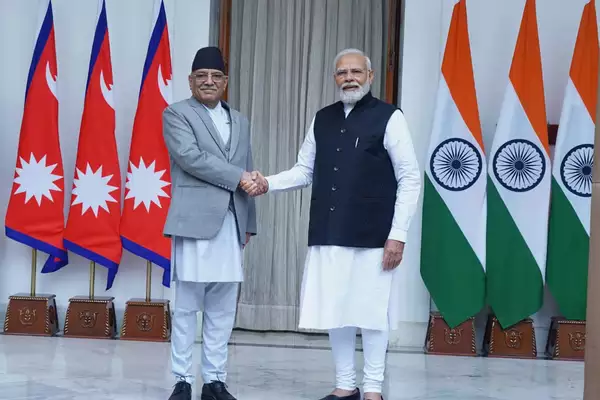India-Nepal Trade Relations: India continues to be the largest trading partner of Nepal, as reported in the Nepal Trade Statistics released by the Department of Customs for the fiscal year 2024-25.
India-Nepal Trade Relations
- Nepal’s trade deficit with India stands at INR 149.17 billion till mid-September of FY 2024-25.
- India has maintained its position as the largest export destination for Nepal, while Nepal ranks as the 17th largest export destination for India.
- Nepal’s Exports to India:
- Hydroelectric power
- Resin
- Agricultural produce
- Yarn
- Handicrafts (e.g., pashmina shawls)
- Silver and gold jewellery
- Hide and skins
- Nepal’s Imports from India:
- Petroleum products
- Chemical fertilizers
- Salt, sugar, and rice
- Vehicles
- Copper and cotton
Historical Ties Between India and Nepal
- Cultural & Religious Links: Shared cultural ties rooted in Hinduism and Buddhism, including the significance of Lumbini in Nepal.
- Geographical Proximity:
- Open borders between the two nations enable unhindered movement of people.
- The “Roti-Beti ka Rishta” exemplifies familial and matrimonial ties.
- Treaty of Peace and Friendship (1950): Provides for reciprocal treatment of citizens, national treatment of businesses, and Nepal’s access to Indian weaponry.
Significance of Nepal for India
- Strategic Importance:
- Borders five Indian states: Uttarakhand, Uttar Pradesh, West Bengal, Sikkim, and Bihar.
- Acts as a buffer state against potential threats from China.
- River Systems: Rivers from Nepal support India’s perennial river systems and hydropower potential.
- Religious Importance: Nepal is a key pilgrim site for Hindu and Buddhist Indians.
Areas of Cooperation
- Trade & Economy:
- India is Nepal’s largest trade partner and source of foreign investments.
- Bilateral trade in 2018-19 stood at INR 57,858 crore (US$ 8.27 billion).
- Connectivity Initiatives:
- Electric rail project linking Kathmandu with Raxaul, India.
- Development of inland waterways for trade facilitation.
- Development Assistance: India supports Nepal in infrastructure, health, water resources, and rural development projects.
- Defence Cooperation: India assists in modernizing the Nepalese Army and recruits for its Gorkha regiments.
- Cultural Engagement: India and Nepal collaborate on art, culture, and academics, and have sister-city agreements (e.g., Kathmandu-Varanasi).
- Humanitarian Assistance: Nepal is a major recipient of Indian aid, especially after natural disasters like earthquakes and floods.
Challenges in India-Nepal Relations
- Territorial Disputes: Ongoing issues over the Kalapani and Susta regions.
- Concerns with the 1950 Treaty: The Treaty of Peace and Friendship is seen by some in Nepal as unequal, with calls for revisions.
- Demonetisation Impact: Nepalese holders of demonetized Indian currency notes face unresolved challenges.
- China’s Growing Influence: China’s Belt and Road Initiative (BRI) is increasing its foothold in Nepal, raising concerns for India.
- Internal Security: The open border has been exploited by insurgents and terrorists.
- Delays in Project Implementation:
- India’s reputation for delaying projects has led to a trust deficit in Nepal.
- Certain ethnic groups in Nepal view India’s involvement in Nepalese affairs as interference in political sovereignty.
Way Forward
- Resolution through Diplomatic Channels:
- Avoid nationalistic rhetoric and focus on sensitive dialogue.
- Negotiations should adhere to international laws on trans-boundary disputes.
- The resolution of the India–Bangladesh boundary issue can serve as a model.
- Sensitising Towards Nepal:
- Proactively engage Nepal in cultural, bureaucratic, and political forums.
- Respect Nepal’s sovereignty while promoting inclusive rhetoric through mutual understanding.
- Strengthening Economic Ties:
- Hydropower trade agreements need to build trust between both nations.
- Buying power from Nepal can help India meet peak demand, saving significant investments in new power plants.
- Bilateral Investment Promotion and Protection Agreement (BIPPA):
- Nepal should encourage Indian investments, combating resistance from local trade associations.
- Communicate that foreign investments from India are welcomed for economic growth.
Ref: Source
| UPSC IAS Preparation Resources | |
| Current Affairs Analysis | Topperspedia |
| GS Shots | Simply Explained |
| Daily Flash Cards | Daily Quiz |
Frequently Asked Question:
What are Nepal’s major exports to India?
Nepal exports hydroelectric power, resin, agricultural produce, handicrafts, and yarn to India.
What are Nepal’s primary imports from India?
Nepal imports petroleum products, chemical fertilizers, vehicles, salt, sugar, and rice from India.
What is the significance of the 1950 Treaty of Peace and Friendship between India and Nepal?
The treaty provides reciprocal treatment of citizens and businesses and allows Nepal access to Indian weaponry.
How does Nepal hold strategic importance for India?
Nepal acts as a buffer state against China and supports India’s river systems, aiding hydropower potential.
What challenges exist in India-Nepal relations?
Challenges include territorial disputes, concerns over the 1950 treaty, and China’s growing influence in Nepal.



